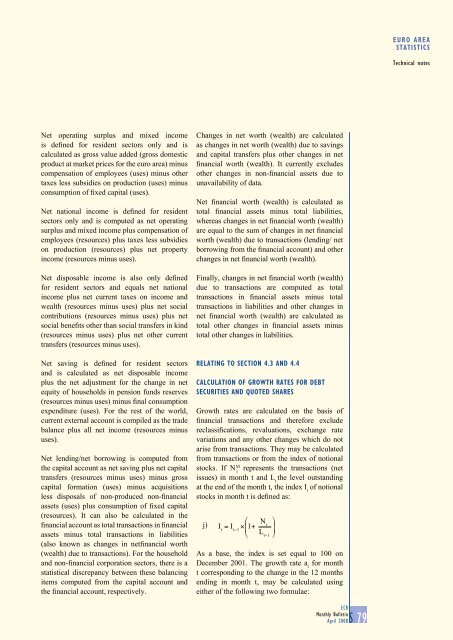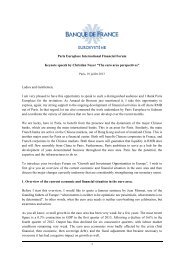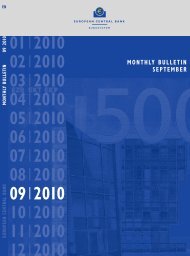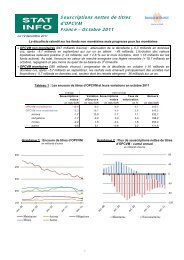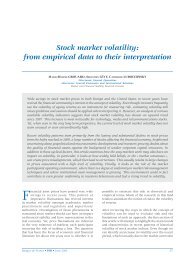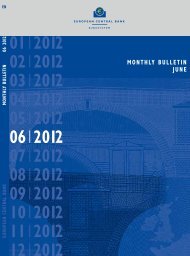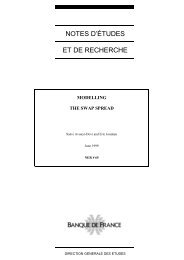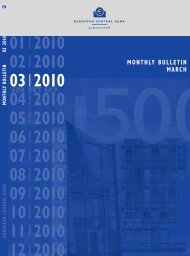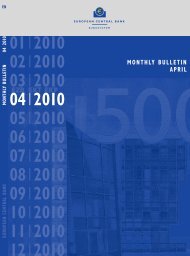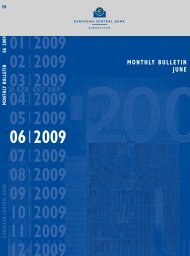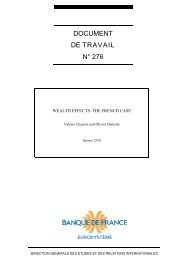Monthly Bulletin April 2008 - European Central Bank - Europa
Monthly Bulletin April 2008 - European Central Bank - Europa
Monthly Bulletin April 2008 - European Central Bank - Europa
Create successful ePaper yourself
Turn your PDF publications into a flip-book with our unique Google optimized e-Paper software.
EURO AREA<br />
STATISTICS<br />
Technical notes<br />
Net operating surplus and mixed income<br />
is defined for resident sectors only and is<br />
calculated as gross value added (gross domestic<br />
product at market prices for the euro area) minus<br />
compensation of employees (uses) minus other<br />
taxes less subsidies on production (uses) minus<br />
consumption of fixed capital (uses).<br />
Net national income is defined for resident<br />
sectors only and is computed as net operating<br />
surplus and mixed income plus compensation of<br />
employees (resources) plus taxes less subsidies<br />
on production (resources) plus net property<br />
income (resources minus uses).<br />
Net disposable income is also only defined<br />
for resident sectors and equals net national<br />
income plus net current taxes on income and<br />
wealth (resources minus uses) plus net social<br />
contributions (resources minus uses) plus net<br />
social benefits other than social transfers in kind<br />
(resources minus uses) plus net other current<br />
transfers (resources minus uses).<br />
Net saving is defined for resident sectors<br />
and is calculated as net disposable income<br />
plus the net adjustment for the change in net<br />
equity of households in pension funds reserves<br />
(resources minus uses) minus final consumption<br />
expenditure (uses). For the rest of the world,<br />
current external account is compiled as the trade<br />
balance plus all net income (resources minus<br />
uses).<br />
Net lending/net borrowing is computed from<br />
the capital account as net saving plus net capital<br />
transfers (resources minus uses) minus gross<br />
capital formation (uses) minus acquisitions<br />
less disposals of non-produced non-financial<br />
assets (uses) plus consumption of fixed capital<br />
(resources). It can also be calculated in the<br />
financial account as total transactions in financial<br />
assets minus total transactions in liabilities<br />
(also known as changes in netfinancial worth<br />
(wealth) due to transactions). For the household<br />
and non-financial corporation sectors, there is a<br />
statistical discrepancy between these balancing<br />
items computed from the capital account and<br />
the financial account, respectively.<br />
Changes in net worth (wealth) are calculated<br />
as changes in net worth (wealth) due to savings<br />
and capital transfers plus other changes in net<br />
financial worth (wealth). It currently excludes<br />
other changes in non-financial assets due to<br />
unavailability of data.<br />
Net financial worth (wealth) is calculated as<br />
total financial assets minus total liabilities,<br />
whereas changes in net financial worth (wealth)<br />
are equal to the sum of changes in net financial<br />
worth (wealth) due to transactions (lending/ net<br />
borrowing from the financial account) and other<br />
changes in net financial worth (wealth).<br />
Finally, changes in net financial worth (wealth)<br />
due to transactions are computed as total<br />
transactions in financial assets minus total<br />
transactions in liabilities and other changes in<br />
net financial worth (wealth) are calculated as<br />
total other changes in financial assets minus<br />
total other changes in liabilities.<br />
RELATING TO SECTION 4.3 AND 4.4<br />
CALCULATION OF GROWTH RATES FOR DEBT<br />
SECURITIES AND QUOTED SHARES<br />
Growth rates are calculated on the basis of<br />
financial transactions and therefore exclude<br />
reclassifications, revaluations, exchange rate<br />
variations and any other changes which do not<br />
arise from transactions. They may be calculated<br />
from transactions or from the index of notional<br />
stocks. If N t<br />
M<br />
represents the transactions (net<br />
issues) in month t and L t<br />
the level outstanding<br />
at the end of the month t, the index I t<br />
of notional<br />
stocks in month t is defined as:<br />
j)<br />
⎛<br />
I t<br />
= I t−1<br />
× ⎜1+<br />
⎝<br />
N t<br />
L t−1<br />
As a base, the index is set equal to 100 on<br />
December 2001. The growth rate a t<br />
for month<br />
t corresponding to the change in the 12 months<br />
ending in month t, may be calculated using<br />
either of the following two formulae:<br />
⎞<br />
⎟<br />
⎠<br />
ECB<br />
<strong>Monthly</strong> <strong>Bulletin</strong><br />
<strong>April</strong> <strong>2008</strong>S 79


